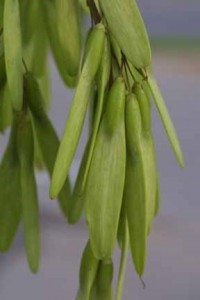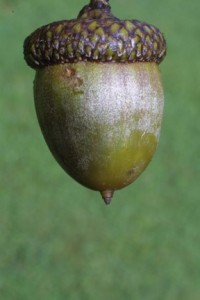YOUR DAILY DOSE OF BOTANY – APRIL 2013
Fruit Salad Part III
Scott Namestnik, snamestnik@orbisec.com
In the March issue of this column in The Plant Press, we looked at the different types of dehiscent dry fruit. This month, we’ll look at the other type of dry fruit, indehiscent dry fruit. As you may recall from last month, indehiscent dry fruit are dry fruit that remain intact with the seeds inside the fruit after the fruit has been shed by the plant.
There are several types of indehiscent dry fruit; the most common type is the achene. Achenes have a single seed that is connected to the locule, or fruit cavity, at only one point. The point at which the seed connects to the locule is the stalk of the ovule, which is called the funiculus. The ovaries of buttercups (Ranunculus spp.) characteristically develop into achenes at maturity. If an achene becomes bladder-like or corky at maturity, it is known as a utricle.

Samaras of white ash (Fraxinus americana). © Steven J. Baskauf, http://bioimages.vanderbilt.edu/.
Ash (Fraxinus spp.) and elm (Ulmus spp.) have fruit that are essentially achenes with papery wings attached. In ash this wing is attached on just one side of the seed, whereas in elm the papery wing surrounds the seed. Regardless of its location, the purpose of the wing is to aid in wind dispersal of the fruit. Also regardless of the wing location, this type of indehiscent dry fruit is known as a samara.
When an indehiscent dry fruit splits into two or more one-seeded parts, called mericarps, the fruit is considered a schizocarp. Carrots (Daucus carota ssp. sativus) and other members of the family Apiaceae have fruit that meet this description. The fruit of maples (Acer spp.) are an interesting case in that they are samaras that split into two parts at maturity. Many people like to call these fruit whirlybirds or helicopters, but I say we should inform them that they are actually considered samaroid schizocarps!
In the composites (Asteraceae), the fruit is an achene-like structure that develops from an inferior ovary. In this case, the fruit is often known as a cypsela, but some botanists still consider this an achene.
Grasses (Poaceae) also have indehiscent dry fruits, but the seed coat of the single seed is attached to the fruit wall. In this case, the fruit is known as a caryopsis, or a grain.

Nut (acorn) of northern red oak (Quercus rubra).
© Steven J. Baskauf, http://bioimages.vanderbilt.edu/.
The type of fruit that most people probably picture when they hear “indehiscent, dry fruit” is a nut. Nuts originate from compound ovaries and have stony fruit walls or outer shells. An oak (Quercus spp.) acorn is a classic example of a nut; the seed is located inside of the acorn.
You can see that there is a lot of variety when you talk about indehiscent dry fruits. Many of these are quite small, and examination and identification is aided by a hand lens. Others are quite large and conspicuous. Regardless, because they don’t break apart to disperse seeds at maturity, fruit in this group can often be observed nearly year-round.
If you have a question about nuts or dry fruit that you would like answered in a future edition of this column, send me an email at snamestnik@orbisec.com. I may not be able to address all requests given the space allotted for this column, but I will answer those that I can.
